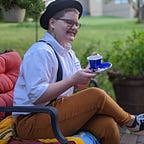Color in Advertising
One of the most expansive uses of color is in advertising.
In an advertisement, the goal is to sell your product to as many consumers as possible, so every aspect of the advertisement needs to be intentional, including color choices.
Blue is an extremely calming color. Studies find that a person is likely to side with a calm, or safe situation than a more intense one, and will be more open to a calmer option. When blue is present in an app icon or ad, it draws consumers in because it doesn’t feel overbearing, like a brighter advertisement might. Blue can also promote ideas of technology, the future, sophistication, intelligence, etc — as is shown the BMW advertisement — so it’s often used to help convince consumers that the product is a better or more advanced option than something else.
Red is often used to advertise a sense of danger. A large number of news sources use red for this reason. This mental association draws people to the news station so that they can be informed of any possible danger occurring. Red is also used to simply catch the attention of the consumer, as it’s such a powerful and bright color, making it useful for large companies like Netflix.
Orange is generally quite bright and easily catches the eye, which is good for marketing. It also has many positive connections that draw people in. Companies like Home Depot might highlight orange in their advertising because orange symbolizes creativity and action, things essential to home improvement.
Yellow is a color used in a lot of nostalgic advertisements or advertisements for older products. This ties back to the idea of Yellow Pages, or Yellow Checker Cabs: things that have existed for a while and used to be popular years ago. Those types of things, known for their use of the color yellow, really support that idea of something vintage, well-loved, or classic. If something is well-loved and has a lot of support, or it seems like it does, more people are likely to buy it.
Green is popularly seen as the color of the environment and is heavily used by environmental organizations/environmentally friendly packaging. It’s also heavily used in bank advertising as green is a color heavily associated with money and the economic world. Having a green color in a bank advertisement can sometimes help convince consumers that a certain bank might bring you money/financial prosperity or help since the connection with green and paper money is so strong.
Violet is often used in advertising to suggest luxury. A brand that wants to sell the idea that their products are luxurious, or nice to use, might use violet as a feature. Violet has been long connected with luxury due to it being the color of royalty in earlier centuries.
Overall, though there are endless options, the intentional uses of color in advertisement are essential. The color used in an advertisement completely sets the intent and mood for an advertisement, and, therefore, determines how many people actually follow up on the product.
